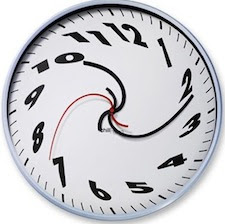What To Do With Time
Back in the day, when I worked in the corporate environment, a couple of my employers used different âpersonality testsâ to gauge how people worked. The idea was that once you knew your own personality type and understood and appreciated that of othersâ, effective work teams for specific projects could be created by pulling in people of various âtypesâ or skill sets. One such test I took at a workshop with my peers was the Myers-Briggs Type Indicator®.
You may be familiar with this. Essentially, the results indicate a number of factors, like if you focus on your outer world (Extraversion – E) or inner world (Introversion – I). If you focus on basic information you take in (Sensing – S) or if you interpret and add meaning (Intuition – N). If you make decisions based on logic (Thinking – T) or looking at the people and circumstances (Feeling – F). And in your âstructureâ in dealing with the outside world, if you get things decided (Judging – J) or you stay open to new options and information (Perceiving – P). (Much like astrological signs or Ayurvedic doshas, we all have a tendency to feel like our âtypeâ is âthe bestâ and the envy of all others.)
Although I would like to think I have shifted a bit in the 15 years since I took the test, at that time I was an off-the-chart J. So, in the clever way these workshops are intended to bring us to our own âa-ha,â a bunch of us likeminded Js were sent off with a handful of extreme Ps, and the same question was posed to each group: âWhat to do with time?â
The responses we Js came up with were spot on and went something like this: organize it, plan it, arrange it, schedule it, divide it. We were going to DO something TO time. We were proud. You see, we Js love a plan. And in order to have a plan, you need to be able to manage time.
When the Ps reported their responses on âWhat to do with time?,â you should have seen the looks our our puzzled J faces as they listed âplay, read, vacation, eat, work, relax.â Hmmmm. We felt a little sorry for them, not knowing what to do with time and all.
Fast forward 15 years, the last eight of which have thankfully included an evolving yoga practice that has helped me improve my relationship with time. I think about what motivates me to spend my time a certain way. Do I feel obligated? Am I pressured by another person? Iâm also more mindful of my actions and how I move through the world, instead of thinking about five things and doing three others all at the same time. My J pendulum hasnât swung completely in the other direction, but letâs just say it has a more moderate placement now.
All of this all came flooding back to me recently as I read an article in Yoga Journal online that posed the question: “Is there a way to live that frees us from the cycle of longing for more time, misusing the time we do have, and then blaming a lack of time for our discontent?”
The author explains how through the yogic practices of svadhyaya, or self-study, and aparigraha, or nongrasping, we can begin to take the steps of developing a healthier relationship with time. She writes, âMost of us live in linear, chronological time, with its clocks and deadlines and pressures. A steady diet of this kind of time starves the most vital, alive, and essential parts of us. But there’s another, richer kind of time: extraordinary time. It’s a state of intense focus, of being in the moment.â
It was a good reminder for me. You might find the article an interesting read, too, if you aren’t too Strapped for Time.
Trust your journey~
Sandra

